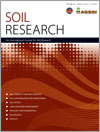SR11281Carbon inputs by wheat and vetch roots to an irrigated Vertosol
There is little information on the amounts of carbon that can be added to soil by crop roots in irrigated cotton rotations. Measurements were made near Narrabri, northern NSW. The experimental treatments were: continuous cotton; cotton–vetch (CV); cotton–wheat (CW); and cotton–wheat–vetch. Carbon sequestered by rotation crop roots was estimated to be ~0.34 t C/ha.year for the vetch and wheat crops in the CWV rotation, 0.10 t C/ha.year for vetch in CV, and 0.08 t C/ha.year for wheat in CW.




